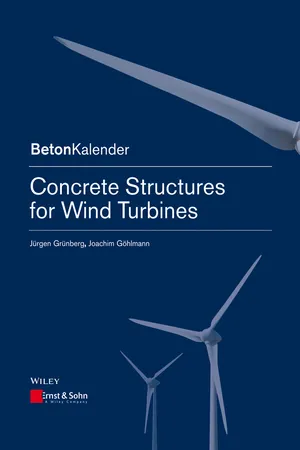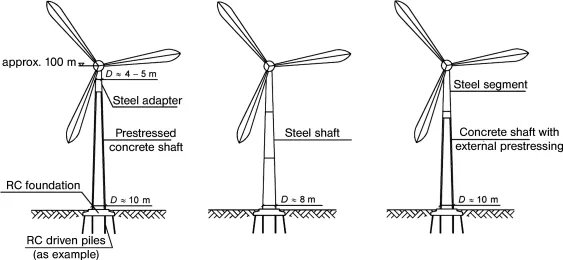![]()
1
Introduction
The wind energy industry in Germany has an excellent global standing when it comes to the development and construction of wind turbines. Germany currently represents the world's largest market for wind energy. So far, more than 21 000 wind turbines with a total output of approx. 25 000 MW have been installed across the country. And at the moment that figure is growing by approx. 2000 MW every year [1]. Developments in land-based installations are moving in the direction of more powerful turbines with more than 3 MW per installation and towers exceeding 140 m in height.1)
However, the number of lucrative sites on land (onshore) is dwindling. Therefore, it is planned to construct wind turbines at sea (offshore) in the coming years. The plans provide for offshore wind farms in the North Sea and Baltic Sea and are intended to increase substantially the proportion of renewable energies in electricity generation. The target for the medium-term is installations in the North Sea and Baltic Sea with a total output amounting to some 3000 MW. By 2030 it is hoped that offshore wind turbines with a total output of about 20 000 to 25 000 MW will have been built [2].
Figure 1.1 shows the results of a study carried out by DEWI, the German Wind Energy Institute. It shows the annual installed wind energy output for each year since 1990 plus the forecast up to the year 2030. According to the study, the decline in onshore installations should be compensated for by the anticipated development in offshore wind farms and by the repowering of land-based installations, leading to a doubling in the annual installed output by the year 2020.
The towers supporting onshore wind turbines are mainly of steel or prestressed concrete with internal or external prestressing. Steel lattice masts are also used in isolated instances. The prestressed concrete towers make use of both in situ and precast concrete. In recent years, the use of hybrid towers, consisting of a prestressed concrete shaft and a steel top section, has proved to be a very economical solution, especially for wind turbines in the multi-megawatt category. The choice of a suitable tower design is governed by the conditions at the site (fabrication, transport, erection, etc.). Figure 1.2 illustrates typical towers for onshore wind turbines.
Both shallow and deep foundations can be used for onshore wind turbines. Soil improvement measures can be employed to upgrade subsoil properties to those required for shallow foundations [4,5]. Driven piles of steel or concrete with appropriate toe forms are frequently used as deep foundations.
So far, about 25 wind farms have been approved for construction off the German coast in the North Sea and Baltic Sea within the 12-mile zone and the exclusive economic zone (EEZ) for water depths of up to 45 m. But the better wind conditions at sea call for a greater technical input for the loadbearing structure and the fabrication and erection of the wind turbines [6]. Besides the depth of the water, the choice of a suitable offshore structure is especially dependent on the wave and current conditions plus the subsoil beneath the seabed. Concrete structures in the form of gravity bases are economic propositions for nearshore sites and for greater depths of water, see [7]. Such foundations are built in a dock, for example, then floated out to their final position and sunk. Resolved designs with individual members made from prestressed high-strength concrete are also feasible. An overview of the offshore foundation concepts currently under discussion can be found in Section 5.
The ongoing development of ever more powerful wind turbines plus additional requirements for the design and construction of their offshore foundation structures exceeds the actual experience gained so far in the various disciplines concerned. Wind turbines represent structures subjected to highly dynamic loading patterns. The load cycles of onshore installations can reach N = 109, but those of offshore installations can be exposed to further load cycles of up to N = 108 due to the sea conditions. Therefore, for the design of loadbearing structures, fatigue effects – and not just maximum loads – are extremely important. This can lead, in particular, to multi-axial stress states arising in the connections and joints of concrete and hybrid structures (see Sections 3.6 and 4.9), which have considerable effects on the fatigue strength and so far have not been addressed in the applicable design codes.
On the whole, there is still a great need for further research in the various disciplines involved in the planning, design and construction of wind turbines. It was for this reason that the Centre for Wind Energy Research ForWind (www.forwind.de) was set up at the Carl von Ossietzky University of Oldenburg and the Leibniz University of Hannover in 2003, thus enabling engineers from different disciplines to work together on research into wind energy. Supported by the Lower Saxony Ministry of Science and Culture, the objective of the centre is to pool research activities. Construction technology research into offshore wind turbines began at the University of Hannover as long ago as 2000 in the shape of the GIGAWIND (www.gigawind.de) joint project sponsored by the Federal Ministry for the Environment, Nature Conservation and Nuclear Safety. These research activities are divided into three areas: actions due to wind and waves, design of loadbearing structures (including foundations) and environmental technology aspects. GIGAWIND alpha ventus is a project associated with the RAVE (Research at Alpha Ventus) research initiative and therefore has access to the extensive programme of measurements carried out at the Alpha Ventus test site, Germany's first offshore wind farm. At European level, the University of Hannover participates in the European Academy of Wind Energy (www.eawe.eu). The objective here is to promote research and development and to train PhD students in the field of wind energy in various European countries.
The basic concepts for the planning, design, analysis and construction of tower structures, focusing on wind turbines especially, will be explored in the next chapters.
Many aspects of these basic concepts also apply to the structural and constructional requirements of other tower-type structures, for example
– telecommunications towers
– radar towers and lighthouses in shipping lanes
– antenna support structures and masts for mobile telephone networks
– chimneys
For more information on these structures please refer to Beton-Kalender 2006 Teil 1, pp. 103–223 [8].
Note
1. Source: Bundesverband der Windenergie e.V. (www.wind-energie.de).
![]()
2
Actions on Wind Turbines
2.1 Permanent Actions
In addition to the typical dead loads of the plant (rotor and nacelle) and the structure (tower and foundation), there are also other loads that are classed as permanent actions: for example the loads of items fitted inside the tower (cables, intermediate platforms, etc.), and those due to further electrical equipment, for example transformers, ventilation systems.
And when it comes to offshore wind turbines there are yet further dead loads to be considered such as external platforms, boat moorings or cathodic corrosion protection.
For the dynamic analysis in particular, the masses of the individual items and components must be known and taken into account accurately in the design.
2.2 Turbine Operation (Rotor and Nacelle)
The actions due to the operation of the turbine are determined by means of numerical simulations (see also Section 4.9.1). In addition to various wind load models, with the superposition of wave action effects where applicable, such simulations must also take into account particular operating situations, for example start...


